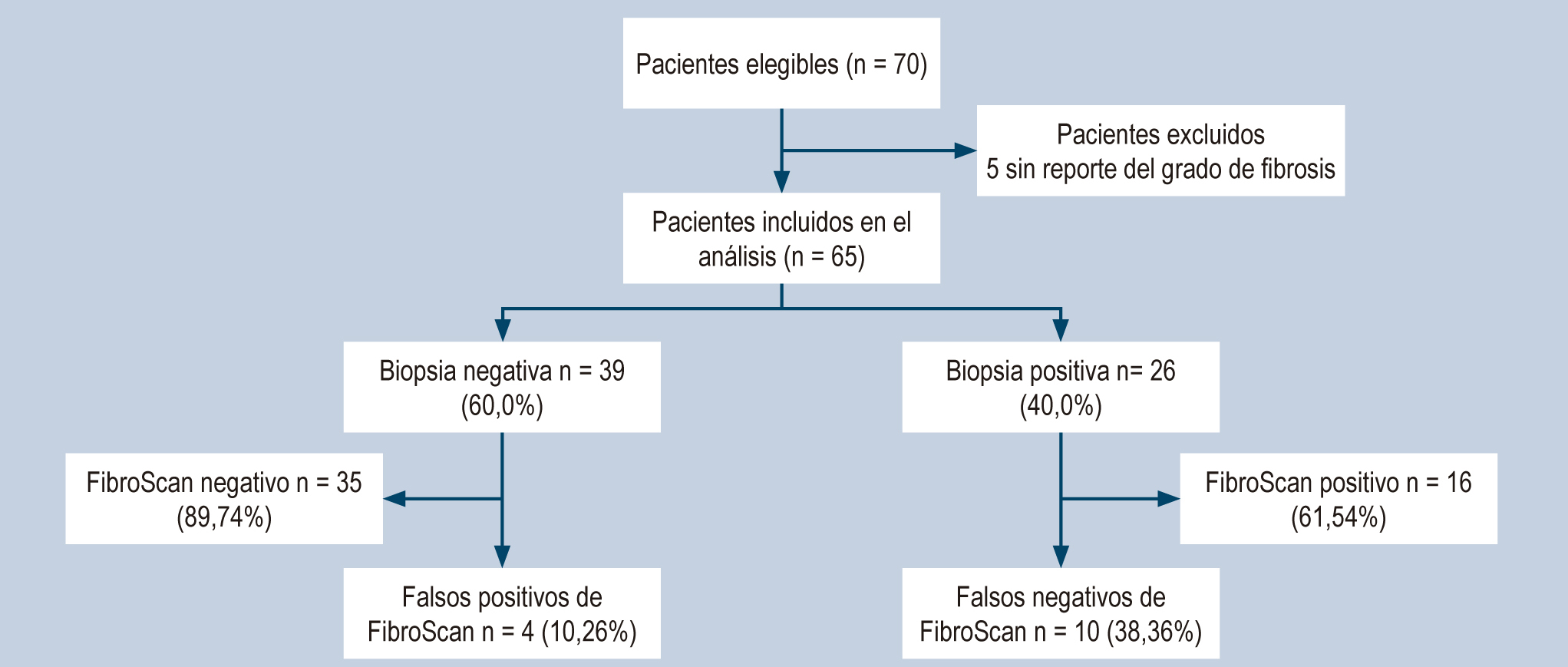Diagnostic Performance of FibroScan in a Liver Disease Center in Bogotá from 2019 to 2022
DOI:
https://doi.org/10.22516/25007440.1097Keywords:
Elastography, FibroScan, APRI, FIB-4, ROC curves, Liver fibrosisAbstract
Introduction: The medical record and liver biochemical profile are essential in diagnosing liver diseases. Liver biopsy is the reference parameter for diagnosis, activity evaluation, fibrosis status, or therapeutic response, but it is invasive and carries risks. For fibrosis staging, easily accessible non-invasive tests without resorting to biopsy have been developed. The FIB-4 and APRI indexes are helpful but do not determine the degree of fibrosis in the early and intermediate stages. Fibrosis can be evaluated using elastography, a sensitive technique to differentiate patients without fibrosis from those with advanced fibrosis.
Objective: To describe the diagnostic performance of FibroScan in detecting fibrosis compared to the APRI and FIB-4 indexes versus the biopsy in a care center for patients with liver diseases in Bogotá.
Methods: A retrospective, cross-sectional cohort study compared the APRI, FIB-4, and Fibroscan with biopsy; diagnostic accuracy measures and an area under the curve (AUROC) analysis were described.
Results: The biopsy was positive for fibrosis in 40%. The AUROC was 0.90 (confidence interval [CI]: 0.83–0.97) for FibroScan, 0.52 (CI: 0.35–0.68) for APRI, and 0.52 (CI: 0.37–0.68) for FIB-4.
Conclusions: FibroScan helps diagnose and monitor chronic liver disease and should be combined with other tests and the clinical picture. FibroScan was better at detecting advanced stages when discriminating against patients with liver fibrosis than the APRI and FIB-4 indexes.
Downloads
References
Liu YB, Chen MK. Epidemiology of liver cirrhosis and associated complications: Current knowledge and future directions. World J Gastroenterol. 2022;28(41):5910-30. https://doi.org/10.3748/wjg.v28.i41.5910
Udell JA, Wang CS, Tinmouth J, FitzGerald JM, Ayas NT, Simel DL, et al. Does This Patient With Liver Disease Have Cirrhosis? JAMA. 2012;307(8):832. https://doi.org/10.1001/jama.2012.186
de Franchis R, Bosch J, Garcia-Tsao G, Reiberger T, Ripoll C, Abraldes JG, et al. Baveno VII - Renewing consensus in portal hypertension. J Hepatol. 2022;76(4):959-74. https://doi.org/10.1007/978-3-031-08552-9
Mózes FE, Lee JA, Selvaraj EA, Jayaswal ANA, Trauner M, Boursier J, et al. Diagnostic accuracy of non-invasive tests for advanced fibrosis in patients with NAFLD: an individual patient data meta-analysis. Gut. 2022;71(5):1006-19. https://doi.org/10.1136/gutjnl-2021-324243
Lemoine M, Assoumou L, De Wit S, Girard PM, Valantin MA, Katlama C, et al. Diagnostic Accuracy of Noninvasive Markers of Steatosis, NASH, and Liver Fibrosis in HIV-Monoinfected Individuals at Risk of Nonalcoholic Fatty Liver Disease (NAFLD): Results From the ECHAM Study. J Acquir Immune Defic Syndr. 2019;80(4):e86-e94. https://doi.org/10.1097/QAI.0000000000001936
Afdhal NH, Bacon BR, Patel K, Lawitz EJ, Gordon SC, Nelson DR, et al. Accuracy of Fibroscan, Compared With Histology, in Analysis of Liver Fibrosis in Patients With Hepatitis B or C: A United States Multicenter Study. Clin Gastroenterol Hepatol. 2015;13(4):772-779.e3. https://doi.org/10.1016/j.cgh.2014.12.014
Castera L, Winnock M, Pambrun E, Paradis V, Perez P, Loko MA, et al. Comparison of transient elastography (FibroScan), FibroTest, APRI and two algorithms combining these non-invasive tests for liver fibrosis staging in HIV/HCV coinfected patients: ANRS CO13 HEPAVIH and FIBROSTIC collaboration. HIV Med. 2014;15(1):30-9. https://doi.org/10.1111/hiv.12082
Riegelman RK, Hirsch RP. Cómo estudiar un estudio y probar una prueba: lectura crítica de la literatura médica. 2.a edición. Washington, D.C., EUA: OPS, OMS; 1992.
Prieto Ortiz JE, Garzón-Orjuela N, Sánchez Pardo S, Prieto Ortiz RG, Ochoa Díaz AF, Soto-Ospina PH, et al. Elastografía en tiempo real (Supersonic), experiencia de un centro en Bogotá. Revista. colomb. Gastroenterol.. 2021;36(1):58-64. https://doi.org/10.22516/25007440.594
Fletcher RH, Fletcher SW, Fletcher GS. Epidemiología clínica: 5.a edición. Barcelona: Wolters Kluwer; 2016.
Lin ZH, Xin YN, Dong QJ, Wang Q, Jiang XJ, Zhan SH, et al. Performance of the aspartate aminotransferase-to-platelet ratio index for the staging of hepatitis C-related fibrosis: an updated meta-analysis. Hepatology. 2011;53(3):726-36. https://doi.org/10.1002/hep.24105
de Lédinghen V, Vergniol J. Transient elastography (FibroScan). Gastroenterol Clin Biol. 2008;32(6 Suppl 1):58-67. https://doi.org/10.1016/S0399-8320(08)73994-0

Downloads
Published
How to Cite
Issue
Section
License
Copyright (c) 2024 Revista colombiana de Gastroenterología

This work is licensed under a Creative Commons Attribution-NonCommercial-NoDerivatives 4.0 International License.
Aquellos autores/as que tengan publicaciones con esta revista, aceptan los términos siguientes:
Los autores/as ceden sus derechos de autor y garantizarán a la revista el derecho de primera publicación de su obra, el cuál estará simultáneamente sujeto a la Licencia de reconocimiento de Creative Commons que permite a terceros compartir la obra siempre que se indique su autor y su primera publicación en esta revista.
Los contenidos están protegidos bajo una licencia de Creative Commons Reconocimiento-NoComercial-SinObraDerivada 4.0 Internacional.


| Article metrics | |
|---|---|
| Abstract views | |
| Galley vies | |
| PDF Views | |
| HTML views | |
| Other views | |














